Tired of your usual seafood options and looking to try something new? Do you want to create a meal that’s both delicious and easy to prepare? I’m excited to share my favorite salmon cakes recipe that yields crispy exteriors and tender, flavorful interiors.
This recipe works beautifully with both fresh salmon fillets and canned salmon, making it versatile for any kitchen situation. The best part? It’s straightforward enough for weeknight dinners but impressive enough for entertaining guests.
Key Takeaways
- Crispy salmon cakes with tender interiors
- Versatile recipe using fresh or canned salmon
- Easy to prepare for weeknight dinners or special occasions
- Perfect for using leftover salmon or as a budget-friendly seafood option
- Nutritional benefits of salmon as a protein-rich, omega-3 packed ingredient
Why You’ll Love These Salmon Cakes
If you’re looking for a simple yet impressive seafood dish, salmon cakes are the answer. These delicious salmon patties are not only easy to make but also offer a perfect balance of flavors and textures.
The Perfect Balance of Crispy and Tender
One of the standout features of these salmon cakes is their texture. It has a crispy exterior, while staying soft and moist on the inside. This contrast is achieved by using the right mix of ingredients and cooking techniques. Whether you use canned salmon or fresh salmon, the result is a delightful culinary experience.
A Budget-Friendly Seafood Option
Using canned salmon makes this recipe extremely budget-friendly while still delivering great flavor. Here’s a comparison of costs for different seafood dishes:
| Seafood Dish | Cost for 4 Servings |
|---|---|
| Salmon Cakes (using canned salmon) | $10 |
| Crab Cakes | $25 |
| Salmon Cakes (using fresh salmon) | $15 |
As shown in the table, salmon patties are a cost-effective option compared to other seafood dishes like crab cakes.
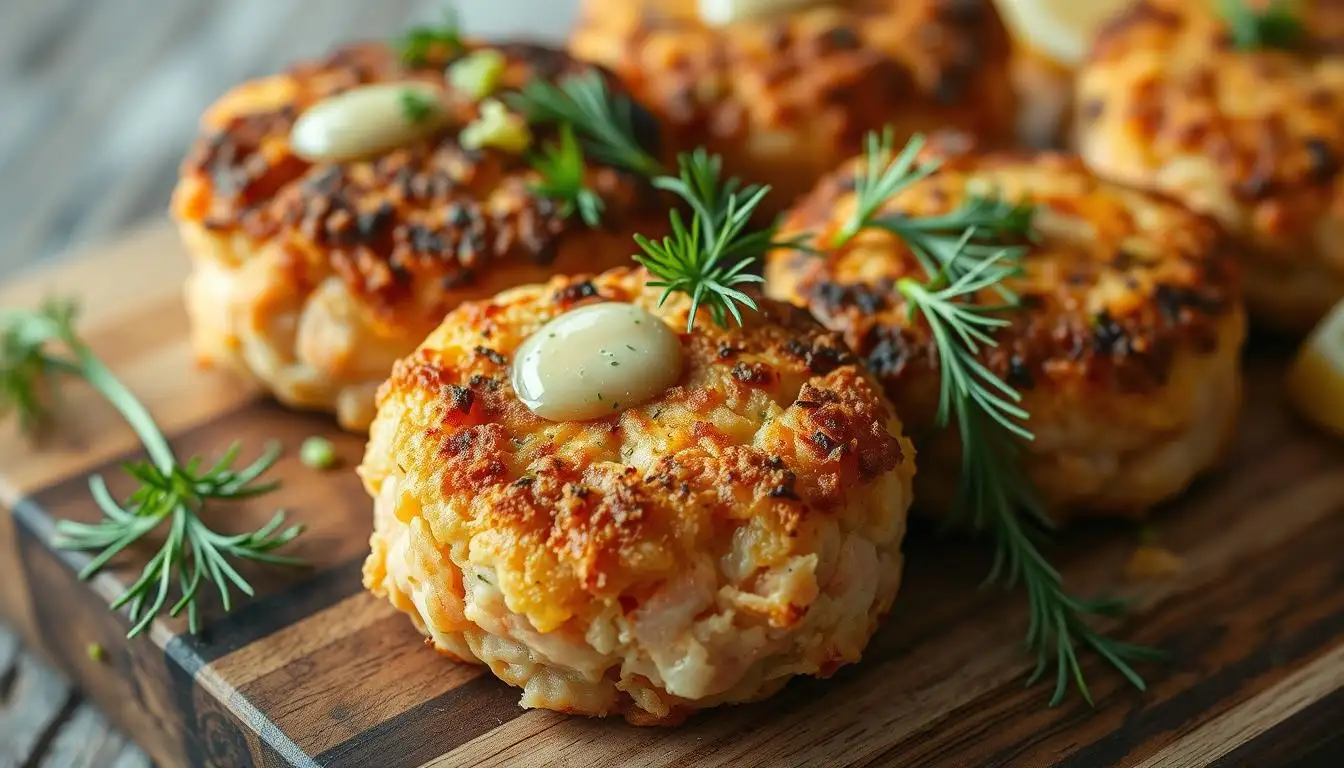
Ingredients for Perfect Salmon Cakes
The foundation of exceptional salmon cakes lies in the quality of their ingredients. To create a dish that’s both flavorful and textured, you’ll need to carefully select the components that make up these cakes.
Fresh vs. Canned Salmon Options
When it comes to salmon, you have two primary options: fresh or canned. Fresh salmon provides a richer flavor and better texture, but it requires more preparation, including cooking and flaking. On the other hand, canned salmon is convenient and still packed with flavor, making it a great alternative. When done correctly, both methods can lead to excellent flavors.
Essential Binding Ingredients
To hold your salmon cakes together, you’ll need binding ingredients. These typically include panko breadcrumbs and eggs. The panko breadcrumbs add a light, airy texture, while the eggs provide the necessary cohesion to keep the cakes intact during cooking.
Herbs and Seasonings for Maximum Flavor
The right herbs and seasonings can elevate your salmon cakes from good to great. Fresh dill and parsley add a bright, fresh flavor, while Old Bay seasoning provides a classic seafood taste. Don’t forget to include garlic for depth, and salt and pepper to enhance the overall flavor. Lemon juice offers a citrusy brightness that lightens the rich taste of the salmon.
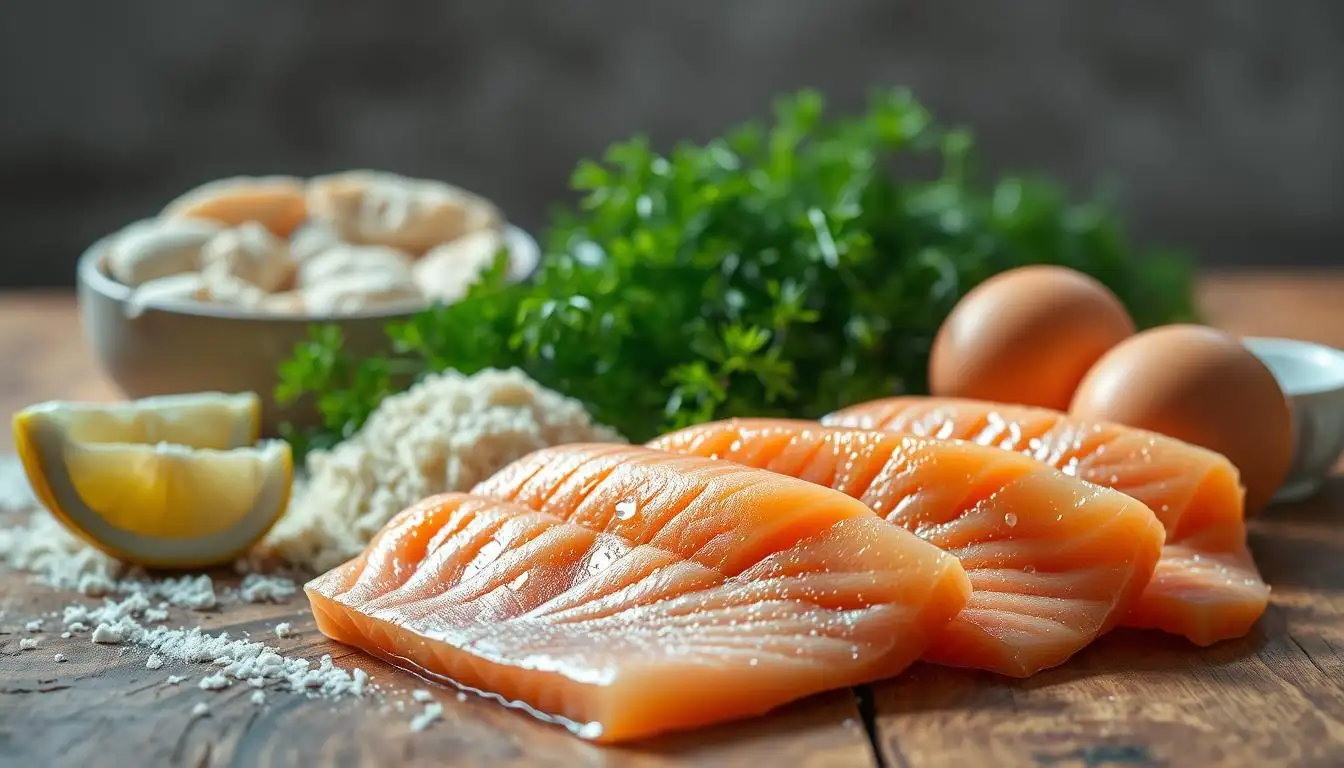
Equipment You’ll Need
Preparing salmon cakes requires a few basic kitchen tools. To start, you’ll need a measuring cup to portion out the salmon mixture and a plate for coating the patties.
Basic Kitchen Tools
You’ll need a mixing bowl to combine your ingredients, a spoon or spatula for mixing, and a plate or tray for forming your patties. A measuring cup is essential for portioning out the salmon mixture to form patties of consistent size.
Optional Helpful Items
Some tools can make the process easier, though they’re not necessary. Scoop the salmon mixture evenly using an ice cream scoop. A food processor can quickly chop vegetables for the mixture. Parchment paper on a baking sheet can make cleanup easier when forming and holding the patties. To prep your salmon cakes, consider using a kitchen scale to measure ingredients precisely, and a splatter guard when pan-frying to reduce mess.
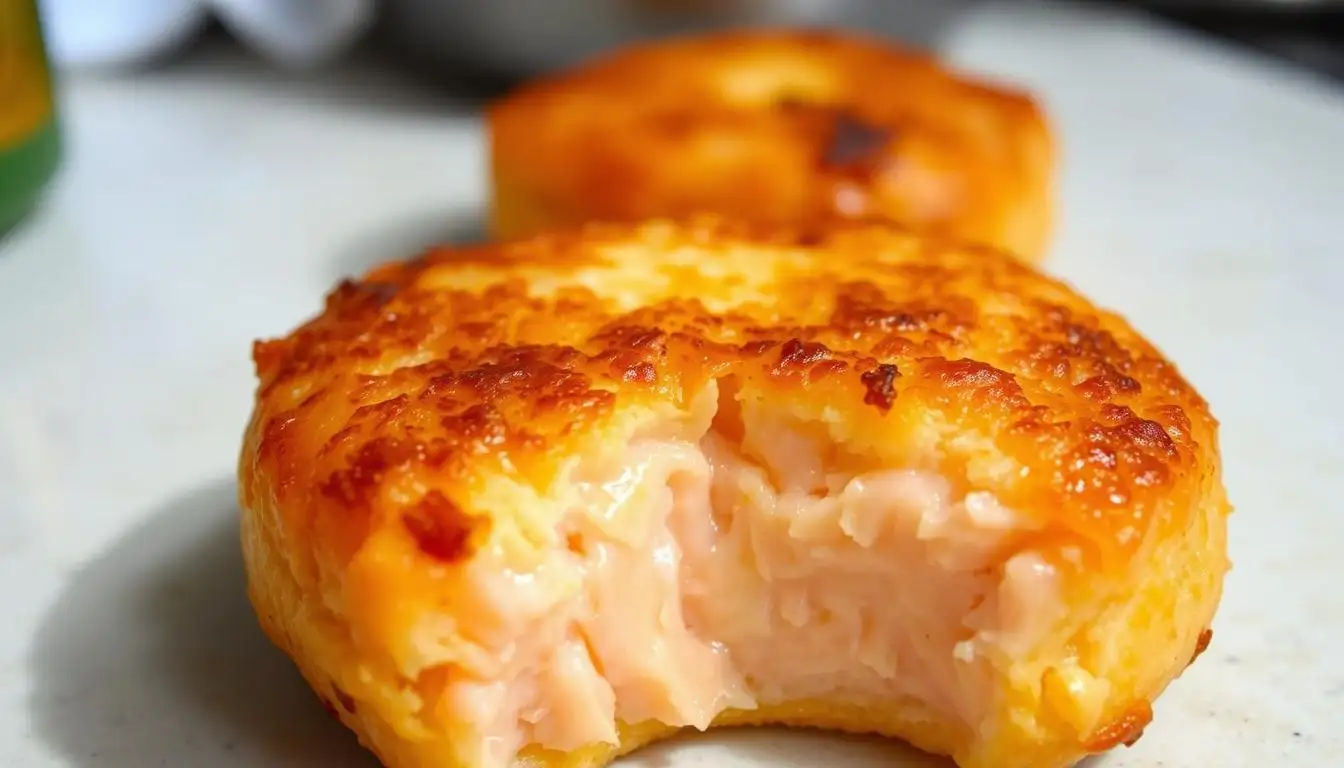
Preparing Your Salmon Cakes Recipe
The process of making salmon cakes begins with cooking and flaking the salmon. Taking this first step is key to developing the perfect texture and flavor.
Cooking and Flaking the Salmon
Cook the salmon until it becomes tender and flakes easily when you press it with a fork. You can bake, poach, or pan-fry it. After cooking, allow it to cool, then use a fork to break it into small flakes. This makes it easier to remove any bones and ensures the salmon has an even texture throughout.
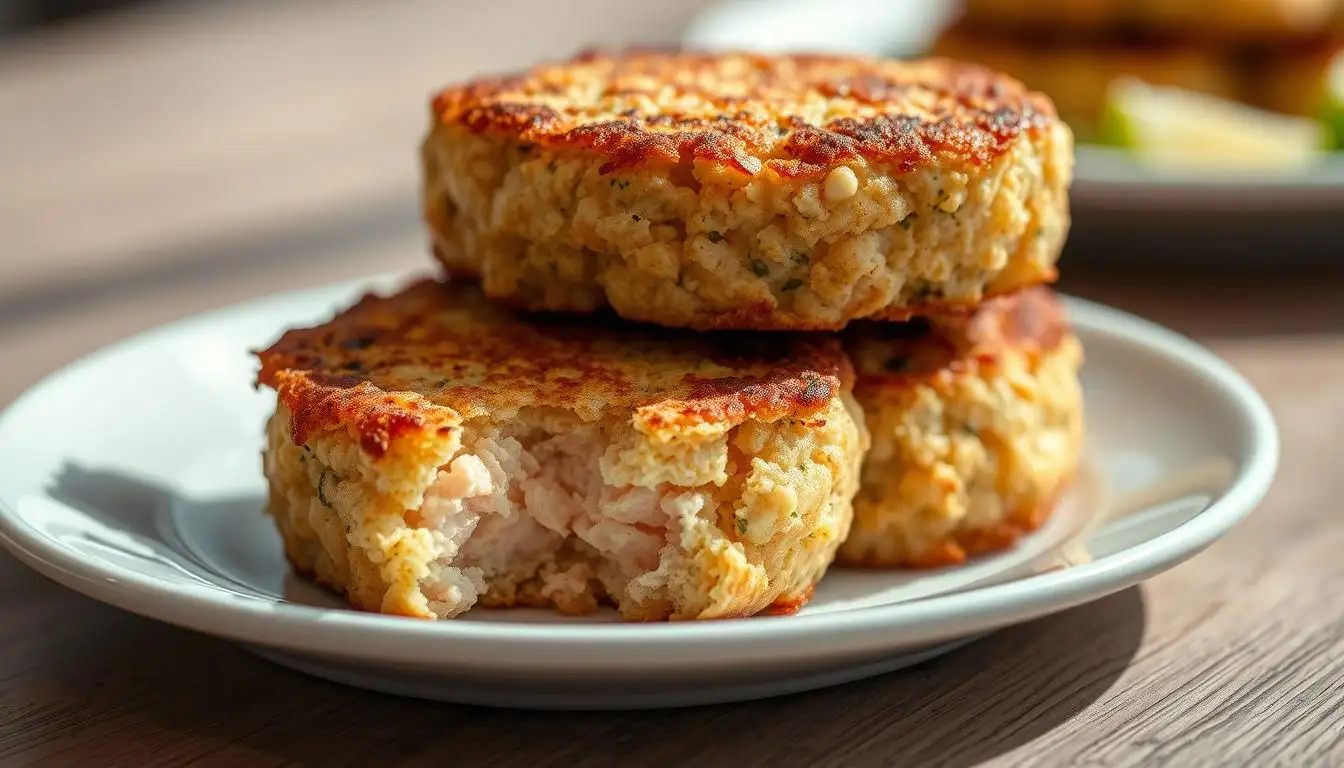
Mixing the Ingredients
Forming Perfect Patties
To form patties, use a flat ice cream scoop to portion out the mixture, then press it into patties about 1/3 to 1/2 inch thick. You can also use a ⅓-cup measure to scoop the mixture and shape it into a compact cake, about 1 inch high.. Chilling these salmon patties for 15-30 minutes helps them hold their shape during cooking.
| Patty Thickness | Cooking Result |
|---|---|
| Too Thin | Cakes may break apart |
| Salmon cakes cooked to perfection | with a thickness ranging from 1/3 to 1/2 inch |
| Too Thick | Cakes may not cook evenly |
Cooking Methods for Salmon Cakes
Cooking salmon cakes can be done through various methods, each offering unique benefits. The method chosen depends on the texture and flavor you wish to achieve.
Pan-Frying for the Crispiest Results
Pan-frying is a popular method for cooking salmon cakes as it yields a crispy exterior. To pan-fry, cook the cakes over medium heat without moving them until they turn golden brown, about 2 minutes per side. If they begin to brown too quickly, lower the heat to medium.
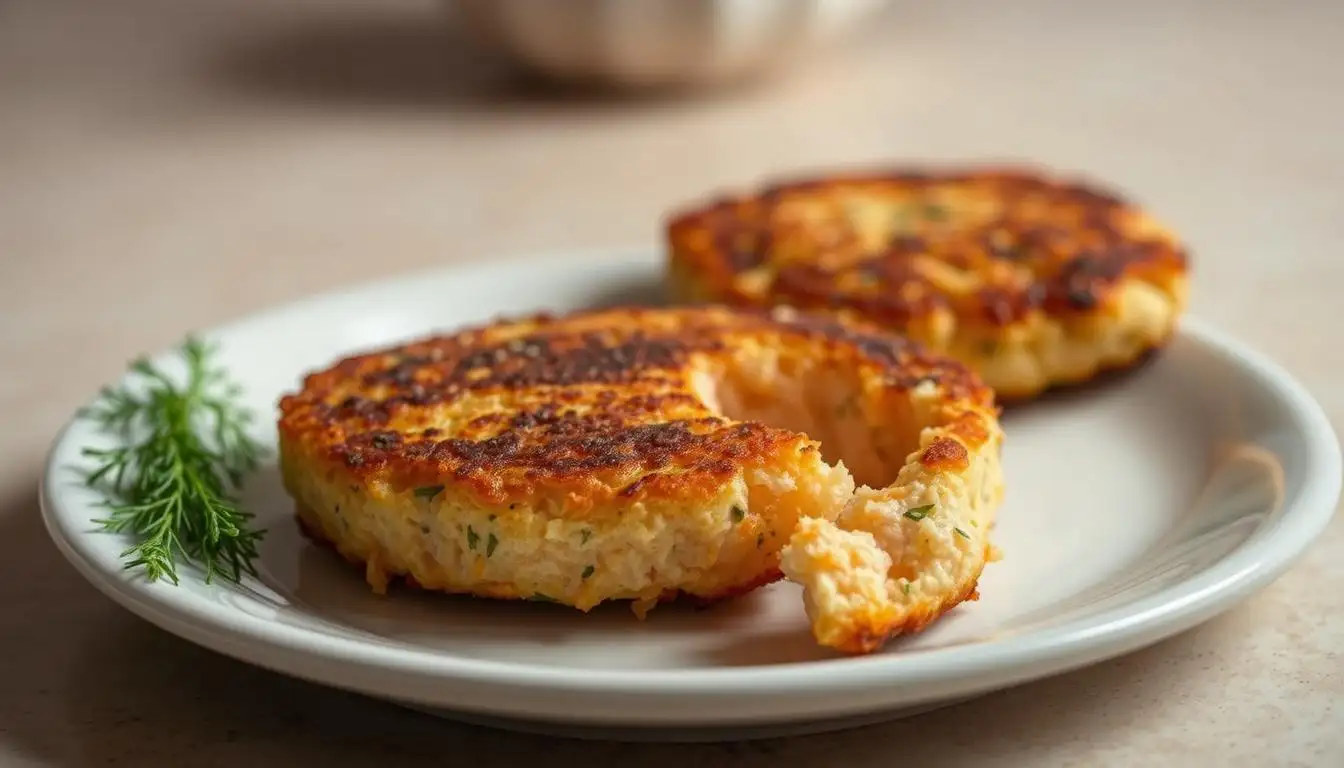
Baking Option for Lighter Cakes
For a lighter version, baking is a great alternative. Simply place the salmon patties on a baking sheet lined with parchment paper and bake in a preheated oven. This method produces a tender cake with less oil.
How to Tell When They’re Done
No matter how you cook it, checking for doneness is a crucial step. The cakes are done when they’re golden brown on both sides, firm to the touch, and have reached an internal temperature of 145°F. The edges should be crisp and well-defined. Here’s a recap of the doneness indicators:
| Doneness Indicator | Description |
|---|---|
| Golden Brown Color | Signals proper caramelization and flavor development |
| Crisp Edges | Become well-defined when properly cooked |
| Firmness to Touch | Indicates the binding has set properly |
| The internal temperature | of fresh salmon should reach 145°F |
My Best Tips for Successful Salmon Cakes
To ensure your salmon cakes turn out perfectly, I’ve compiled some valuable tips. Making delicious salmon cakes is not just about following a recipe; it’s about understanding the nuances that make them truly special.
Preventing Your Cakes from Falling Apart
To keep your salmon cakes intact, make sure you’re using the right binding ingredients. I’ve found that a combination of panko breadcrumbs and egg works well to hold the cakes together. Be gentle when forming the patties, as excessive pressure can cause them to break apart during cooking.
Achieving the Perfect Golden Brown Crust
Achieving a golden brown crust is all about the right cooking technique. Pan-frying is my preferred method, as it allows for a crispy exterior and a tender interior. Make sure the pan is hot before adding the cakes, and don’t overcrowd it.
Make-Ahead and Storage Options
You can prepare the salmon mixture up to 24 hours in advance and refrigerate it before forming the cakes. Formed, uncooked patties can be refrigerated for several hours before cooking. Cooked cakes can be refrigerated for up to 3 days or frozen for up to 3 months. Proper storage makes this recipe an excellent meal prep choice, saving you time in the long run. Simply place them on a plate and store in the refrigerator.
Delicious Serving Suggestions
One of the joys of making salmon cakes is experimenting with different serving suggestions. I love these salmon cakes for brunch over a green salad with vinaigrette, but they also make a delicious dinner alongside rice pilaf and roasted asparagus.
Homemade Tartar Sauce Recipe
A homemade tartar sauce can elevate your salmon cakes to the next level. To make it, you’ll need mayonnaise, chopped pickles, lemon juice, and fresh dill. Simply mix these ingredients together and adjust the seasoning to taste. This sauce adds a tangy and creamy element that complements the salmon cakes perfectly.
Side Dishes That Pair Perfectly
Choosing the right side dishes can create a well-rounded meal. Here are some suggestions:
| Side Dish | Description |
|---|---|
| Green Salad | A fresh green salad with vinaigrette dressing provides a light and acidic contrast to the richness of the salmon cakes. |
| Rice Pilaf | Rice pilaf or roasted potatoes can add satisfying carbohydrates to your meal, making it more filling. |
| Roasted Asparagus | Roasted vegetables like asparagus or Brussels sprouts share similar cooking temperatures with salmon cakes, making them easy to prepare together. |
Conclusion
I’ve discovered that using fresh or canned salmon, you can create mouth-watering salmon patties that are both healthy and flavorful. This recipe is perfect for any occasion, from casual family dinners to entertaining guests. The techniques shared ensure success even for those new to cooking seafood. The balance of crispy exterior and tender, flavorful interior makes these salmon cakes irresistible. I encourage you to try both fresh and canned salmon versions to find your preference and share your results in the comments.

